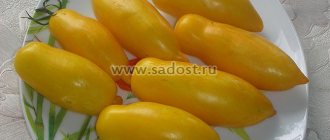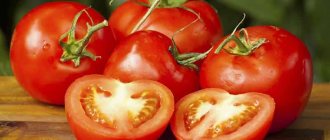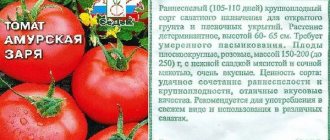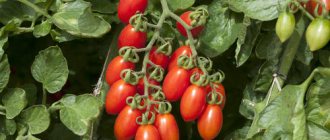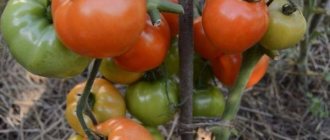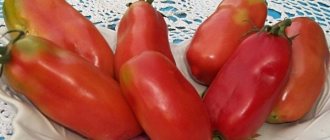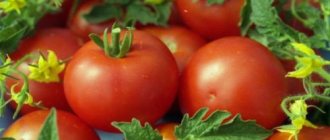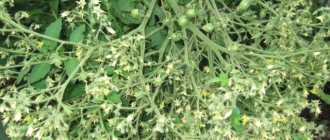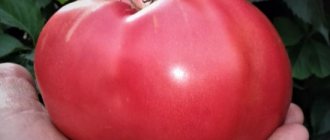Smoothie is a large-fruited salad tomato. It ripens late, but produces tasty and aromatic fruits. The variety is suitable for summer residents and owners of personal plots in all regions of the Russian Federation.
| Height | Landing location | Ripening time | Fruit color | Fruit size | Origin | Fruit shape |
| Tall | Open ground | Mid-season | Reds | Large | Variety | Heart-shaped |
Description and characteristics of the variety
The cultivar was included in the register of breeding achievements in 2007. But it was released much earlier - in 2001. The originator is Ztek Aelita LLC (Moscow), author Lyubov Anatolyevna Myazina.
Heartbreaker is a tall variety for growing in open ground. In early spring it can be covered with film or Agrotex.
The ripening period is mid-season, the first fruits ripen on the 115th day. Bush height up to 170 cm.
Tomatoes are heart-shaped with small ribs, loose, and contain a lot of juice. When ripe, they are bright red, there are more than 6 nests. Average weight is 170 g, the taste is excellent.
There are multi-colored forms, but with similar characteristics:
- tomato Heartbreaker yellow,
- pink heartbreaker tomato,
- raspberry heartbreaker tomato
Fleshy, heart-shaped tomatoes contain a lot of sugar and little acid that is harmful to the stomach, so they are suitable for dietary nutrition.
Features of cultivation, planting and care
It is advisable to sow the seeds of this tomato variety for seedlings 60-65 days before planting in the ground. When planting in a permanent place, 1 sq. up to 3 plants are placed per meter of plot. If you form one stem, you can place up to 4.
This is a natural variety of tomato. Therefore, we recommend taking seeds from a ripe fruit and using them for planting in subsequent seasons.
If you grew Heartbreaker tomatoes, please write whether you liked them or not. What was the yield and taste of the fruits like under your climatic conditions? How do you rate the disease resistance of this variety? Briefly describe the advantages and disadvantages of this variety in your opinion, and evaluate its taste. If possible, attach a photo of the entire bush or individual fruits you grew to your comment. Thank you!
Your reviews of the Heartbreaker tomato and additions to the description will help many gardeners evaluate this variety objectively and decide whether it is worth planting or not.
Forum statistics
208686 Messages in 1636 Topics from 5641 Users. Last user: Cerberus Last message: “Rooting wine cuttings...” ( Today at 06:57:45) Latest messages on the forum.
Now on the forum
49 Guests, 20 Users
Users in the last 15 minutes: Grandfather Igor, Marina Protasova, Elena Aleshchenko, freesia, Elena Z, Oleg Ivanovich Zavezen, Vova Kapran, Vitaly Kholkin, Lyuda5, Timofey, yotmast, Antrikan, Alexander Sh, Svetlana Korotina, Evgeniy 50, Tikhii, kvg , Dmitry Anatolyevich, Evgeniy30, Ilya 77 [Blocked] [Section Moderator] [Forum Moderator]
Maximum online today: 112 . All-time maximum online: 2758 (28 July 2021, 17:22:51)
Users who visited the forum in the last 24 hours
Total: 323
(Visible: 322, Hidden: 1) 1963, Grandfather Igor, Marina Protasova, Elena Aleshchenko, freesia, Elena Z, Oleg Ivanovich delivered, Vova Kapran, Vitaly Kholkin, Lyuda5, Timofey, yotmast, Antrikan, Alexander Sh, Svetlana Korotina, Evgeniy 50, Quiet, kvg, Dmitry Anatolyevich, Ilya 77, Evgeniy30, thanatos, Mikhail Alekseevich, dralexk1, leonidych, zsb, Ivan Levin, Oleg56, 25nata35, ElenkaF, Linx, vladimirM, GALINA ANOKHINA, G.V, Alexey V, Casperzrq, Elvira2017, Alexander Vl., Natasha, DIL, Lyubov S., YurSanych, Capricorn, Nikolai Mikhailovich, Alexander K, vlad51, Andrey 31, Evgeniy 163, Evgen_Ev, Tatyana Provorova, Skif, Victor B, Nikolay Lipunov, sergei, Evgeniy52, 77volt , hanter64, Tatyana B, kosmos, slavalimon, Mikhail77, skier, rivaN, y_fed, Kazak, Igor Sergeevich, Victor55, Andrey15, OlgaOs, DorontsovPeter, Chapai, Buba, Mikhno Alexander, alexsandr, Amber7394, SANYCH, Pioneer, DimaRostov, Dmitry 77 , Verona, DED2, MaxL, nicson7, Vasily V., Kenig, Alexander Taganrog, VitaliySD, Dmitry-Kozadoev, Realist, Alexey Deminov, Elektronik_t, Galinka, DSW, Alexey Agryzkov, Taker, Kadyrov, bonami, antar, Sergey 1965, Andrey gladilin, SvetlanaBondareva, tolya, Nadezhda Grig, Naumov Igor, Igor F., Pavel 64, Volgar, Roman Fedorovich, igor222, max2008-01, Iv Iv, Vika, Andrey Lis, lomakin1969, linalenadavi, gheo55, Sergey Chistokletov, mystic69, Grinya , Cherkessk, Andrey, Vladimir Berdnikov, and.drew, Maximilian, Denisovich, Yura Soshnin, Sasha57, Natalia Nikolaevna, Yuri Gaivoronsky, weather forecaster, Lydia58, Vyacheslav03, Sa-shura, irahelm, Pitko, Volodya R, Volgogradka, Alexander71, Natalia1968, Valentina Ivanovna, L. A.P., dayton, marlin64, Tanyusha, Vasily1111, Yuri 14, Dmitry Nikolaevich, Oleg Filippov, Valery Rastorguev, Kalevanych, AlexsandrP, LeXa_KoT, Sergey Yuryev, Inna161, cfibr, stenlly2010, rambo, maxbul, Nadymchanka, Eduard., nik2 , Serginio, potap05, nadia, VeraNiK, Sergey Tashchiyan, Amateur gardener, Alexander-ask-34, Vladimir Kostochkin, Wintel, Vyacheslav Vladimirovich, mers, Izhitsa, Ramiz, Akhmed, gardener, P7N, alexss, Zaur, TITOVA LYUBOV, Sergey Ko, Tatyana Volzh, Grandfather Young, Pioneer-2, ketch, Bublichenko Alexander M, Ildar, Sergei Vasilevi4, Helga, Marshal, Vasily 53, Den, Alexander150, Yavgen3678, vikbublik, Valerie, Henry, Alexander_89, nick041, Svetlana Streletskaya, neposny , yak, Vladimir Buturlakin, Yagodka, Aprel, Antonk1983, PS-URA, spotlight, Nikolay S., Andrey68, Alexander565, Gennady163, AndSanych, Alexander Guy, Alex65, kdm57, oleg9f, Dmitry Badaev, Belgorodets, Yura, formula1, Cerberus, 64nikolay64, Yuri Semyonov, Kryn, N.A. Sokolov, TIS, Guram, sem_en, Alexander Smirnov, AlexanderD, Spikina Galina, Anatoly Sivkov, Snezhinets, Alexey Sh., mira567, Mst, victor_, Vadim, Salex, Yuri P., Bison, Vardan, cecet71, Coltrane, Alexander 61, Andrey Beribesov, Efimych, boltik, Vladimir-27, Vovka, LOZA, ilja, Unter, Gela, Irinka, NatalyaMed, ichtiandr, Sergey Lomonosov, krasnovlad1, Irene, Pirko Alexander, Khramov, YATATYANA, , Mihalych., ni, Vladimir Kovba, Rita, nau_63, Yuri72, Lisav, niy1, NelyaS, MikhAf, Alexander Zinoviev, Zayac, SNovichek, Tatyana A., VDV, Dmitry-Ivanovich, Saisan, slaviking, court, Vladimir Shilov , Swedov Oleg, Sergey2017, Masha_gardener, Burundukx, Lamo, Oleg A., arnyusha, Leonty Yarygin, Vyacheslav-56, lena, Igor 31, Sergey 31, Zhorzhovich, nut lover, Enych, turist, Ewgeniy, Ivan Shmelev, atseton, Liza
Features of the Heartbreaker variety
The Orange Heartbreaker tomato is a semi-determinate species. An adult plant reaches a height of about 1.7 m. It requires artificial growth arrest by removing the upper shoots of the bush.
The plant has a strong trunk and spreading branches. The foliage is narrow, of regular shape, light green in color, and does not densely fill the bush. The Heartbreaker variety is mid-season. From the moment of the first shoots to the first harvest, about 110 days pass.
The tomato inflorescence is normal, the first ovary is formed after 5-6 leaves. There are usually 3-4 large fruits on the hand. Heartbreaker tomatoes produce extended fruiting. The variety has high yield. From 1 bush you can harvest 5 kg of tomatoes per season.
This type of tomato receives the best reviews from both consumers and gardeners, who note not only its excellent taste, but also its ease of cultivation. The plant has good immunity to many fungi and pests, and is resistant to late blight and tomato mosaic.
Gardeners, despite its stability, still recommend periodically preventative spraying of the beds before the fruits appear. Before sowing seeds, you can disinfect planting material with special preparations.
Characteristics, ripening period
The Heartbreaker variety belongs to the type of medium-sized, mid-ripening tomatoes. An adult bush reaches a length of about one meter. This variety is notable for the fact that it does not require any special additional care: the plant does not take steps. The leaves also do not need pruning, since there are few of them.
A tomato fruit weighs 200-300 grams, but sometimes can reach a weight of up to 500 grams or even more. The pulp is pink in color and has a small number of seeds. The skin is thin, but hard and elastic. This name of the variety is directly related to its shape. The shape resembles a heart: the tomato is slightly elongated, but the base is slightly pointed. The color of the fruit is red with a pink tint.
The ripening period is about 90 days. Heartbreaker has good yield. Usually it reaches up to 4 kilograms from one bush.
Advantages and disadvantages, reviews and advice from experienced agronomists
Tomato Heartbreaker has numerous advantages:
- Care does not include stepsoning. Free formation of bushes shows higher yields compared to formalized plantings.
- Early fruiting. The first collection can be carried out already in mid-summer.
- Quality of tomatoes. The fruits are not only large, but also healthy. The dietary composition is suitable for including nightshades in the diet of people who are forced to follow a diet.
- The variety is resistant to minor cold snaps and tolerates frosts.
- Plantings extremely rarely suffer from disease.
- The thin skin is not prone to cracking; tomatoes can be transported.
- Storage is possible at cool temperatures.
No deficiencies identified.
Reviews:
- Greenhouse tomatoes are large in size. On average, the fruits have grown by 500-600 g. The harvest ripens on the cluster, the tomatoes do not fall. The pulp is sweet, with a bright aroma. At the same time, the tomato is suitable for preparing baby food or dietary dishes (Nadezhda, Moscow region)
- The Heartbreaker tomato always bears fruit, regardless of the weather or pest activity. In order not to cover the plantings, you can delay planting the seedlings a little, for example, until mid-May (Lyudmila, Rostov region)
The best heart-shaped tomatoes
The first “heart” tomatoes were Pink and Red Bull's Heart; now the line of varieties has expanded significantly.
Thanks to the work of breeders, you can choose options based on fruit color, taste and other characteristics. Let us describe the heart-shaped tomatoes that have received the most positive reviews from gardeners from different regions. Most heart-shaped tomatoes have very fragile bushes and thin stems. Considering that the fruits are usually large, you cannot do without a high-quality garter. Indeterminate bushes should be grown in 2, maximum 3 stems. For convenience, we will divide the varieties according to the color of the tomatoes.
Pink varieties
They differ from others in that they have a delicate taste, a pleasant pulp consistency, thin skin, and contain an increased amount of dry matter, sugars, and antioxidants. Gardeners often praise tomatoes such as Yasha Yugoslavian, Sensei, Fatima, Minusinsk pink, Cardio, Kosovo, Japanese, Mikado Sibiriko, African Liana. We will describe the best varieties in more detail:
- Ukrainian Miracle of the Earth. Mid-early tomato for open beds and greenhouses. The bush is indeterminate. Immunity to disease is excellent; in rainy weather there is a risk of cracking. Tomatoes from 350 grams to a kilogram, the first ones are the largest, then gradually become smaller. The taste is good, sweet, absolutely no acid, aroma with fruity notes. Productivity is high.
- Russian beauty. Approved for cultivation in all regions in open and closed ground, as well as under film covers. It ripens in the middle period, the bush is indeterminate. Productivity up to 9 kg/m². The plant is resistant to fusarium and tobacco mosaic virus. The tomatoes are dense, slightly ribbed, weighing from 160 to 380 grams. The taste is sweet without acid.
- Dad. An early ripening, indeterminate variety for cultivation in greenhouses and greenhouses. Immunity to disease is excellent. Tomatoes from 150 to 450 grams, slightly ribbed, medium density, fleshy. The taste is excellent, there is no acid. Productivity up to 3 kg/m².
Red varieties
Traditional red tomatoes most often have a sour taste, weak or pronounced. They have less lycopene content than pink ones. To begin with, let's list the varieties and hybrids that 80% of summer residents like: Bulgarian and Belarusian Heart, Cone, Walford's Miracle, Andijan, Inseparable Hearts. Now let's move on to describing the best varieties:
- Vater Rein. Mid-season, semi-determinate (up to 1.5 meters) tomato for greenhouses. Tomatoes with an elongated nose weigh from 350 to 700 grams, sometimes up to a kilogram, fleshy, sweet, dense. Productivity is high, immunity to infections and pests is good.
- Budenovka. Designed for greenhouses, film shelters, planting in exhaust gas is possible only in the south. The ripening period is mid-early, the bush is indeterminate. The fruits are heavily ribbed, ranging from 150 to 400 grams. The taste is rich, balanced, pleasant. Productivity is about 9.5 kg/m².
- Kangaroo heart. Mid-season, indeterminate variety for open ground and greenhouses. The plant is unpretentious, resistant to negative weather factors, diseases, and pests. Productivity up to 14 kg/m². The tomatoes are fleshy, dense, have a dessert, sweetish taste.
Productivity
Plants grown under cover produce more fruit. 8-12 kg of tomatoes are harvested from one greenhouse bush. In open ground, the variety can produce 3.5-5 kg of gigantic tomatoes. Their skin is thin.
Easily separated from the pulp. The largest tomatoes form subspecies with dark skin.
Variety "Bull's heart red"
They taste sweet, with a slight sourness. The inside is fleshy, dense, not juicy. They can be eaten fresh, added to salads, or used for canning and preparing various dishes.
Interesting ideas for decorating your favorite cottage with your own hands | 150+ original photo tips for craftsmen
To obtain the maximum number of fruits in the central part of Russia, it is recommended to plant plants in a greenhouse. In most cases, they are planted in open ground only in the southern regions.
Bull's heart orange F1
It is grown by seedlings. The Bull's Heart variety is considered a demanding variety of tomatoes.
We plant the ox heart without any shelter. We follow all the rules of agricultural technology. To avoid fungal diseases, we carry out preventive measures a few weeks after planting. Tomatoes grow big and don’t get sick. Irina
Preparing seeds for sowing
Seeds are sown in early spring. The seeds of the plant can be prepared independently in the fall, so they retain their varietal qualities. The exception is the varieties - F1 hybrids.
The following activities should be carried out:
- Place the seed material in melt water for 12 hours. You can take clean snow and put it in a warm place, or take ice out of the freezer. Melt water should be at room temperature.
- Disinfect the seeds in a solution of potassium permanganate. Seeds are poured into a slightly pink solution of potassium permanganate and kept for no more than 45 minutes. Then pour the liquid into a strainer. The remaining seeds are washed with clean water.
Brad's black heart tomato
For me, “Bull’s Heart” matures very slowly. By the end of summer, pink specimens only appear. The main part ripens after harvest. I get no more than four tomatoes in my brush. Sidorenko
Sowing seedlings
Soil from the store is selected from the island. If the soil mixture is prepared independently, it should include:
- leaf soil
- peat
- river sand
- humus
Traditionally, wooden boxes or plastic containers are chosen as containers for planting. Fill the container with soil so that the soil does not reach 3 cm to the edges.
Sowing is carried out in pre-treated, moist, warm soil. Sowing depth – 1-2 cm. Distance between adjacent seeds – 2-3 cm.
Ripe tomato White Oxheart
After planting, the boxes are covered with transparent glass, a bag and placed in a warm place. After the first shoots appear, the shelter is removed. The box is placed in a bright place in the house.
Picking is done after the formation of 2-3 true leaves. At the same time, weak plants are removed and strong ones are transplanted into separate cups or into a more spacious box.
Hardening of seedlings
The process of hardening seedlings
Before transplanting to a permanent place, it is recommended to harden off the grown seedlings. To do this, on warm, sunny days they are taken out to the balcony, loggia or garden. The time spent in the air is increased daily.
Transplanting seedlings
Seedlings are transplanted into the greenhouse at the end of April, beginning of May. The exact timing depends on climatic conditions and the availability of heating in the greenhouse. It is recommended to plant tomatoes in open ground only in the second half of May and early June, when the danger of night frosts has passed.
Bull heart pink
If it is cold or damp outside, it is recommended to postpone transplanting seedlings to a permanent location until weather conditions improve.
Soil preparation
The soil in the area for tomatoes must contain a sufficient amount of nutrients and be air and water permeable. The pH of the soil should be between 6-6.5. You should choose a part of the garden with plenty of sunlight, but without drafts and close groundwater.
Soil preparation
It is recommended to prepare the place for seedlings in the fall by adding organic fertilizers to the ground during digging. If the soil was not enriched with organic matter at the end of the season, in the spring you should add 8-10 kg of compost or humus per m2.
It is also useful to sow green manure plants in the tomato plot in early spring:
- radish
- alfalfa
- mustard
- phacelia, etc.
If nutrients were not added either in the fall or in the spring, mineral fertilizers should be added to each hole during planting. For example, 1 tsp. nitrophoska.
The best predecessors for tomatoes: onions, root vegetables, legumes, cabbage, annual herbs.
Rules for landing in a permanent place
When growing Oxheart tomatoes in a greenhouse, be prepared for the tomatoes to take up most of the cover. This is due to the fact that they are planted in a greenhouse, leaving a distance of 1 m between the beds. The distance between two bushes is at least 40 cm.
Planting depth is 12-15 cm. Planting to a greater depth is possible, but about 4-5 cm should remain between the surface of the earth and the first true leaf. According to experienced vegetable growers, 1/3 of the stem can be buried - up to the cotyledon leaves, but not more.
Planting seedlings in open ground
If the seedlings are planted under cover, the air temperature in it should be 20-22 C during the day and 16-18 C at night. Until the seedlings take root, it is recommended to shade them during the hot sun.
We have many years of experience in growing the variety. In central Russia they do not ripen on bushes. Therefore, either they should initially be planted under cover, or already green tomatoes should be brought home and left to ripen in a warm place. But in a greenhouse they are more likely to suffer from late blight. Lyudmila The best 46 varieties of tomatoes for the greenhouse: descriptions with photos and reviews about them
Plant care is no different from other nightshade varieties and includes:
- watering
- feeding
- loosening
- ventilation of greenhouses
- stepsoning
- mulching
- tying
Watering
The variety is considered drought-resistant. After transplanting to a permanent place, during the rooting of newly planted young plants, there is no need to water them. As soon as the bushes begin to actively grow, watering can be resumed.
On average, for 1 m2 of beds 1-2 times a week you need 5-7 liters of liquid for young plants, 12 liters for adult bushes.
Watering tomatoes over the leaves can cause fungal diseases
On hot days, during the ripening of tomatoes, the maximum amount of water is required - up to 15 l/m2.
For irrigation, you should use warm (20-22 C) settled water. The soil should be moistened early in the morning or evening. Bull's heart tomatoes should be watered only at the root, avoiding water getting on the stem and leaves.
Ventilation of the greenhouse
On warm days, greenhouses need to be ventilated daily. In hot weather, shelter windows should be kept open. Overheating the room can hinder the pollination process.
When growing tomatoes, the greenhouse must be regularly ventilated
The air humidity under the shelter should be 65-70%.
Planted in the Pushkinsky district of the Moscow region. I couldn't ripen them outdoors in open ground. My mother-in-law planted it under cover, and it was ripe before it was removed. Tigrov
Bush formation
Bull's heart bears fruit well when the bushes form into one stem. The top of the stem is removed when 7-8 clusters with fruits form on the plant.
Stepsoning
"Bull's Heart" is heavily overgrown with stepsons. If you do not remove them in time, this leads to the fact that the bushes devote all their energy to their growth. At the same time, the fruits grow small. Therefore, this variety is not recommended for novice gardeners to plant.
Bull's heart tomatoes need staking
Pinching is the removal of excess shoots on the leaf axils. It is recommended to remove the stepsons when their length has not yet reached 5 cm. Until this moment, there is no risk of injury to the plants. The growth of such shoots must be monitored regularly. Usually the need to remove new stepsons arises every week.
Top dressing
During the growing season, tomatoes are fed 3-4 times. If signs of deficiency of any elements are noticed, the number of procedures can be increased. But nutrient mixtures are applied no more than once every 2 weeks, alternating root and foliar feeding.
Fertilizing
It is recommended to use organic matter as fertilizer. For example, chicken manure, diluted with water in a ratio of 1:15, cow manure - 1:10. Minerals can only be applied 2 months before harvest.
Recipes for preparing natural fertilizers for tomatoes
No. 1. Iodine Place 4 drops of iodine in a bucket of water. Water 2 liters for each plant. The product is not only a fertilizer, but also helps the bushes resist late blight. No. 2. Ash Add 100 g of ash to a bucket of water. Water under each bush. No. 3. Herbal infusion Add 5 buckets of water to 5 kg of cut grass. Add some ash and mullein. Keep for several days. Water is added to the liquid so that the final volume is 100 liters. To water 1 bush you need 2 liters of mixture. No. 4. Yeast 11 g of dry yeast are diluted in warm water. Add 2 tbsp. Sahara. The resulting mixture is poured into a bucket of water. Each tomato is watered at the root with 500 ml of liquid.
Feeding tomatoes with natural fertilizers allows you to get an environmentally friendly product
Tying up
Plants with long stems can be tied up immediately after planting to a permanent place of growth. To do this, usually take a peg about 2 m long and bury it in the ground next to the bush.
Then the stem is tied to this peg. To prevent the top of the plant from drooping and breaking under the weight of the fruit, the location of tying is changed as it grows.
The long stems of the plant do not allow it to be grown without tying it up
You need to make sure that the tomatoes do not come into contact with the ground, as in this case they begin to darken and rot.
Mulching
The ground can be mulched with sawdust, peat, straw, etc.
To facilitate the process of caring for bushes, the ground under them can be covered with a 5 cm layer of mulch.
It performs the following functions:
- holds water in the soil
- eliminates the possibility of weed growth
- protects tomatoes in contact with the ground from rotting
Pollination
Tomatoes growing outdoors can easily be pollinated by insects and wind. There is no free air circulation in the greenhouse, so it is recommended for such plants to help in this process.
Greenhouse tomatoes sometimes need help with pollination
During flowering, some gardeners recommend simply tapping the pegs to which the plants are tied. This should be done in the morning or in the evening. Landscaping your site with your own hands - (130+ Photos of ideas & Videos) + Reviews
